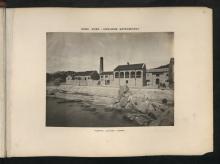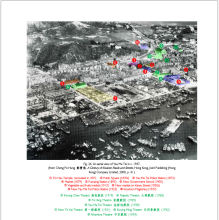I had a wander around Yau Ma Tei yesterday, and came across this old building that I hadn't noticed before. A search on the web brought me to the AMO's "HERITAGE IMPACT ASSESSMENT REPORT OF YAUMATEI THEATRE AND RED BRICK BUILDING"
Here are some of the main points from that report, but it's worth reading the full document - it contains more information, together with maps, plans and photos.
“Red Brick House” on No. 344 Shanghai Street is the only surviving building of a 19th-century waterworks complex, the Yau Ma Tei Pumping Station. The original architectural drawings of this complex show that the complex consisted of three two-storey buildings and a tall chimney for the boiler.
The architecture is of utilitarian design, and typical of the British industrial building typology. The walls are of red engineering brick; the roof and floor of timber construction. The building is almost completely devoid of decoration, except for some decorative brickwork features. Its significance lies in the fact that it is the oldest surviving waterworks building in Hong Kong, and it is a good example of Hong Kong’s industrial heritage in the late Victorian era.
Completed in 1895, Yau Ma Tei Pumping Station pumped fresh water for use by the local population from several wells in the vicinity. Red Brick House is the two-storey building that housed the Overseers’ Quarters on the upper floor, and according to a sign on the building, the Antiquities Authority has officially named it as the “Engineer’s Office of the Former Pumping Station, Water Supplies Department.” In 1911, the pumping station ceased operation. In 1912, the chimney was demolished and the buildings under went the following adaptive reuse:
- the building that had housed the Engine House and the Boiler House was converted to a post office;
- the building that had housed the Fitters’ Quarters and Workshop became a hazardous goods store; and
- the building that had housed the Overseers’ Quarters and Office became a hawkers control office.
Elderly residents of Yau Ma Tei still remember the pre-war and early post-war days when Yunnan Lane (by the side of the post office) became a place where professional letter writers set up their stalls, and as one residents interviewed recalled, there were as many as 37 stalls. The stalls of letter writers—a collapsible table and two chairs—was a common sight outside many post offices in Hong Kong. This traditional trade gradually disappeared after the war with raising literacy among the Hong Kong Chinese population.
In 1967, the post office (Fig. 7) ceased operation with the opening of the nearby Kowloon Central Post Office. The vacated post office was used as a “Street Sleepers’ Shelter” operated by the Salvation Army, a role that lasted until the end of the 1990s, when the shelter for the homeless moved across the street to the building on 345A Shanghai Street, where it remains in operation to this day.



Comments
Post Office in 1915
The Public Works Report for 1915 refers:
172. Conversion of a portion of old Pumping Station at Yaumati into a Branch Post Office-
As it was desired to establish a Branch Post Office at Yaumati and as the old Pumping Station, now disused, was sufficiently central for the purpose, a portion of it was utilized, the necessary alterations being made.